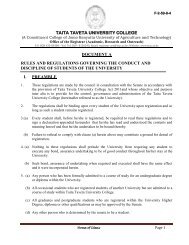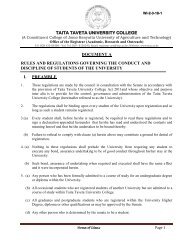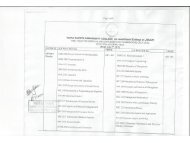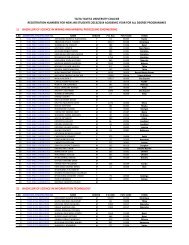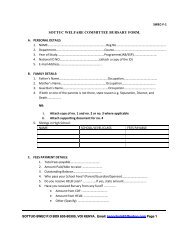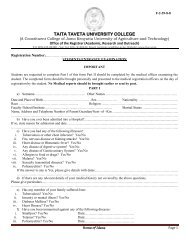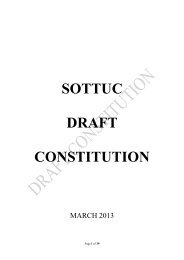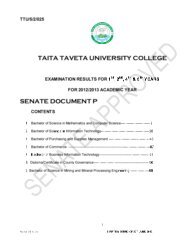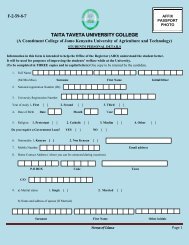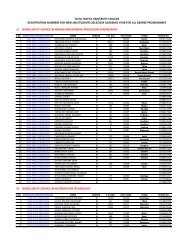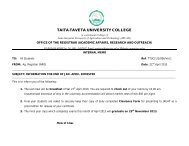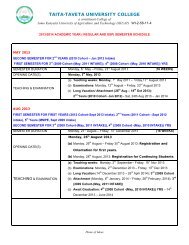What do mining engineers do?
What do mining engineers do?
What do mining engineers do?
You also want an ePaper? Increase the reach of your titles
YUMPU automatically turns print PDFs into web optimized ePapers that Google loves.
<strong>What</strong> <strong>do</strong> <strong>mining</strong> <strong>engineers</strong> <strong>do</strong>?Jack Caldwell | November 9, 2012Over a span of nearly forty years consulting to the <strong>mining</strong> industry, I have worked with many<strong>mining</strong> <strong>engineers</strong>. On the basis of long experience, I can say with confidence that <strong>mining</strong><strong>engineers</strong> spend most of their time in meetings, listening to consultants and staff and makinghard decisions about the mine they work for or manage.When they are not in meetings, the <strong>mining</strong> <strong>engineers</strong> that I have known drive around the openpit, or descend the underground workings where they walk around to see if things are going asthey should. And if things are not going as they should, they talk (mostly) to the people who aresupposed to be making things go properly and the <strong>mining</strong> <strong>engineers</strong> remind them of their dutyand the consequences of failing to live up to their duty.Sometimes the <strong>mining</strong> <strong>engineers</strong> leave the mine and go to the office building in some distant citywhere the head office is located. There they meet with even more senior <strong>mining</strong> <strong>engineers</strong>,accountants, and lawyers to discuss the legal and financial operation of the mine they manageback home. Then they go to a fine restaurant for supper and a night in an expensive hotel to flyback, first-class, to the mine the next day.I <strong>do</strong> not wish to imply by this brief overview of the daily life of the average <strong>mining</strong> engineer thattheir work is easy. For the variety and challenge lies in the diversity of topics and issues the<strong>mining</strong> engineer will face each day in those meetings and round-the-mine travels. Today the<strong>mining</strong> engineer will be faced with a decision to purchase or not to purchase land next to themine where there may or may not be additional ore to expand the mine. The next day the <strong>mining</strong>engineer will be asked by the chief exploration geologist for an increase in budget to enable moredrilling to be undertaken on the land that was purchased the day before.That afternoon the permitting department will demand additional staff to negotiate the permits foroff-site drilling and disposal of the resulting muds from the drill rig. The health and safety officerwill be insisting that the necessary health and safety plans are not in place and that new work beput on hold until the necessary <strong>do</strong>cuments are approved.The next day the topic of the meeting is a shortage of equipment to expand pit operations to theprojected high-grade zone. Then a meeting on dwindling capacity in the tailings impoundmentand the cost of expanding the impoundment or using the old worked-out open pit. That leads to afull-scale review of operating budgets with the planners and accountants just arrived on site fromhead office. They are under instructions from the directors to increase profit by cutting expenses;none of the mill managers or equipment operators can see the sense of this, for they all neednew equipment to replace the old stuff.
To check if the mill superintendent really <strong>do</strong>es need new equipment, the <strong>mining</strong> engineer takes atrip to the mill. He has never really understood the intricacies of this mill and he knows the millsuper is smarter than he is and has been around a lot longer. They banter good-naturedly for awhile. They walk around the equipment which all seems unrusted and humming. Productionnumbers are steady; the preventive maintenance program is functional. The equipmentreplacement costs are huge, and the mill super persuasive. The mine manager knows what to<strong>do</strong>: kick the decision up to the head-office mechanical <strong>engineers</strong>. Let them take the fall or praisefor wrong or right decisions and the need to find more money.The <strong>mining</strong> <strong>engineers</strong> that I write of here, may have received their degree at Colora<strong>do</strong> StateUniversity, Queens, the University of British Columbia, or one of the other few places that stillaward <strong>mining</strong> engineering degrees to a small cadre of students. They will have studied, like most<strong>engineers</strong>, basic maths, physics, chemistry, and calculus. Then a few courses in basic <strong>mining</strong>theory: what makes an underground mine; the essence of open pits; basic blasting theory; andmaybe a bit of finance and accounting. Maybe a short course on environmental studies, socialpolicy, sustainable propaganda, and community relations.The <strong>mining</strong> engineering student would have helped out at a few conferences where professorsand consultants market to each other via papers based on case histories and ideas recirculatedfrom decades past. The student will have met the leaders of industry and recruiting agents for bigand mid-sized <strong>mining</strong> companies. Well before graduation, the offers would have come in.Salaries of from $65K to $100 K depending on the size of mine, the personality of the student,academic record, and remoteness of mine site. The best students would have been flown firstclass to Nevada and the mine of choice, put up in a fine hotel in Toronto, and promised car andfirst month of rent on an apartment. Thus the entry into the <strong>mining</strong> work place.Let us call her Linda. She graduated as a <strong>mining</strong> engineer in Australia. She met and married herhusband at university where he did a masters in mine planning and operation. She preferred thework face: into water-proof clothes, <strong>do</strong>wn the shaft, through the mud to the drills and rock. I mether at a mine in the far north of Canada to which she and her husband were transferred. Shewas then chief <strong>mining</strong> engineer and had to guide me and her underlings through uppermanagement review of a decision to expand the tailings facility. She was beautiful, smart, andvery demanding. We always prepared thoroughly for meetings with her, for she could bore <strong>do</strong>wninto the details faster than any other person that I have ever met.Yet she was kind and gentle. When we were ready to present to upper management, she grilledus and made us practice until we were word perfect. Then she would introduce us to theassembled finance committee and support us to success. I readily admit that it was her skilledjudgment about what to say and what to leave out that led us to win every budget battle and getsenior management approval for all our proposals.
Now she and her husband are in Lon<strong>do</strong>n, England at company headquarters and I am told thatshe is guiding the making of multi-million <strong>do</strong>llar decisions each day. I can believe that, for shehas the skill. Her husband is still in a back engineering office planning new mines and avoidingthe spotlight.There are generally few <strong>mining</strong> <strong>engineers</strong> at a mine. There are sure to be more mechanical,chemical, and civil <strong>engineers</strong> than <strong>mining</strong> <strong>engineers</strong> at a typical mine. For there is a lot moremechanical, chemical, and civil work than <strong>mining</strong> work to be <strong>do</strong>ne at the typical mine. The <strong>mining</strong>engineer however is the boss, the mine manager, the chief mine planner, the executive officer,the primary decision maker. The <strong>mining</strong> engineer aims to leave the management of the mine to ayounger souls and move up the ladder to head office, there to buy and sell mines, negotiatedeals, and set budgets and schedules.Some <strong>mining</strong> engineering graduates go on to <strong>do</strong> a masters degree—and then go into consulting,for a masters is the working degree of consulting to the <strong>mining</strong> industry. And if you are a <strong>mining</strong>engineer without a masters but about ten years practical experience at mines, you too can cometo the city to work for a consultant. I have worked with <strong>mining</strong> <strong>engineers</strong> in consulting who designthe underground workings or layout the new open pit mine. They run computer codes thatsimulate material movements, calculate operating costs, and schedule repairs. They usecomputer codes to calculate slope stability, quantify overburden stripping ratio, and henceestablish the economics of an ore body in a cold northern land.A month ago, I sat in a tall glass building in Santiago, in a cool room of expensive finishes. Theconsultant <strong>mining</strong> <strong>engineers</strong> presented fifty slides on the cost estimate for a new mine to bebrought into production in 2020. The consultants had reviewed three previous cost estimatesmade by other consultants in the past five years and had sought to bring precision and accuracyto the wildly varying previous estimates. The new consultants spent twenty minutes on the issueof the daily cost to feed a worker at the fly-in, fly-out camp. At least one <strong>mining</strong> engineer hadspent the past month researching this issue.We civil <strong>engineers</strong> then botched things up. We presented brief, detail-less slides telling that thecost of tailings disposal would exceed $2 billion. “Do you have detail for that?” the client’s <strong>mining</strong><strong>engineers</strong> asked. “Not really,” the reply. “For the cost depends on so many things out of ourcontrol, and in the control of you the <strong>mining</strong> engineer, that we thought it best for you to <strong>do</strong> it.”The <strong>mining</strong> engineering consultants jumped at the chance and are still working on this one as faras I know.The point is that <strong>mining</strong> <strong>engineers</strong> span the range from the most detailed oriented to the highest,big-picture thinkers. As in all branches of engineering, there are the creators, the dreamers, the
idealists, the philosophers, the soldiers, the warriors, the workers, those who inspire, those whomanage, those who lead and those who follow.Some work in the dust of the veldt, in the heat of the desert, in the snow & cold of the north, inthe rain of the tropics, and in dangerous and remote places. Some prefer the delights of bigcities, rapid transit, impossibly high rents, and school costs, and the comfort of multi-stories, airconditiontowers. Some like the gray, cool stone of research universities. Some like the hustle oforganizing conferences and competing as academics with honest consultants.Some write books, some write EduMine courses, some churn out academic papers on sociallyresponsible <strong>mining</strong> and sustainable development. Some go work for investment firms where theyuse advanced statistics to pick potential stock winners and losers.Some found their own junior <strong>mining</strong> companies. With geologists, they find new ore bodies,engage drillers, write press releases, list stocks, encourage investors, skim a few <strong>do</strong>llars, andsucceed or fail as the market fluctuates in response to Chinese demand. Some junior <strong>mining</strong>company <strong>mining</strong> <strong>engineers</strong> go bankrupt. Some go on to fortunes, when they sell out to a midsizedcompany. They thrill to the trek into the forest, and peering through a magnifying glass atvisible gold in a core specimen. They thrill to the sound of a drill rig echoing in the canyon, thethud of a box of new core, and the geologist’s remarks on grubby paper: ore heavy with silver.Some <strong>mining</strong> <strong>engineers</strong> prefer the three martini lunch with rich investors come from Europeanand Arab capitals. They thrill to the haggle of money invested, dividends promised, the dailymovement of share price, the speculation of the take-over bid, and the large check that quantifiesthe gamble and its success. They wear pin-striped suits of impeccable cut set off by ties of silkand high price. They pity their cousins in torn jeans, T-shirt, steel-toed boots, and the dust of ahot land rover somewhere in an African country. Certainly they would not change places one withthe other.I have never met a <strong>mining</strong> engineer working for a regulatory agency. Admittedly there are somein MSHA, OSHA, and other Washington agencies overseeing the USA <strong>mining</strong> industry. Theirwork is critical to mine safety, and their publications (which I read avidly) are impeccable andimpressive. These are a small part of the <strong>mining</strong> engineering fraternity. They prove the immensediversity of <strong>mining</strong> engineering pursuits and endeavors. They demonstrate that if you choose tostudy <strong>mining</strong> engineering that is only the beginning. Once graduated there is an infinite variety ofopportunities out there just waiting for you to choose one or more lifestyle that suites yourinstincts, interests, abilities, and life-style choices.Keep in mind that you <strong>do</strong> not have to study <strong>mining</strong> engineering to enter the <strong>mining</strong> industry. Youcould become a civil engineer and develop <strong>mining</strong> infrastructure: the roads, bridges, shafts,structures, and tailings facilities that are key to <strong>mining</strong>. You could become a mechanical
engineer: manage the shovels, the trucks, the crushers, and spreaders, and the pipes andpumps of the mine. You could become a chemical, process, or metallurgical engineer an<strong>do</strong>versee extraction of minerals from the ore. Or become an environmental engineer and take careof air quality, surface water and groundwater quality and all the other potential impacts of a mineon its surroundings.Lawyers and accountants, human resource professionals, and health and safety specialists areneeded at the mine. If you like working with people and communities, study community relationsand then go <strong>mining</strong>. All of these professions bring personal and financial rewards at mines farand near.As a <strong>mining</strong> engineer, you may have to lead and manage all these professionals. In addition youwill have to deal with labor unions, politicians, NGOs, terrorists who would burn <strong>do</strong>wn your coreshack, and journalists come to write sensational stories of the impact of the mine on nativepeoples. You will have to be the face of the mine and the <strong>mining</strong> industry in the community. Youwill have to open schools and hospitals, attend sports events, and give presentations at learnedconferences.You as a <strong>mining</strong> engineer will travel far and wide. You will work in Africa, Australia, Nevada,Chile, and the cold parts of Sweden and the Yukon. You will move your family often and yourwife and children will attend many schools and learn many languages. You will be part of a small,but international community. You will meet at the SME conferences in western cities of the USA.You will share stories of hardship, challenges overcome, of mines opened and closed, of politicalmovements and environmental forces that are even now changing the way we see andimplement <strong>mining</strong>.You will thrill to elections and the appointment of a new EPA administrator. You will fight lawcases to the Supreme Court to get the permits you need to open a new mine and close an ol<strong>do</strong>ne. You will travel the wilds of Spain and the places where they have mined gold for 2,000years as you seek to get community support to reopen an old Roman mine and provide jobs tobut 400 of 4,000 applicants thrown out of work by crazy German bankers intent on cuttingnational budgets. You will have to articulate the benefits of <strong>mining</strong> to native groups who believefish transcend profit; to historians who value ruins over new mills; to the rich who live around bigcopper deposits and <strong>do</strong> not want their retirement homes impacted by heavy equipment.In the next twenty years, as a <strong>mining</strong> engineer, you will have to redefine how we go about<strong>mining</strong>: <strong>do</strong> we only high grade and filter press the tailings to dry stacks? Do we avoid sensitiveareas and only operate in remote deserts? Do we desalinate sea water to make <strong>mining</strong> possiblein deserts where people would rather not live, or <strong>do</strong> we undertake perpetual water treatment inwet climates that are getting warmer by the year and subject to bigger and bigger storms andflood? Do we reopen historic mines in Spain and Romania where unemployment is rife? Or <strong>do</strong>
we go to the Amazon and Zambia and deal with tyrants in Zimbabwe and South Africa whowould nationalize our finds and our mines created by long education and hard work?For the future of <strong>mining</strong> is not a repeat of the old ways. If we are to prosper as societies, we needto mine in new ways. And the future of <strong>mining</strong> and the benefits of civilization depend on the ideasand skills of <strong>mining</strong> <strong>engineers</strong> yet to be educated. I am optimistic. For I have children andgrandchildren who reject my opinions and prejudices. So too I am privileged to work with young<strong>engineers</strong> who reject my ways and perspective. They and you, as a young <strong>mining</strong> engineer, willhave to overthrow all that we know and <strong>do</strong>, and reinvent the world to make it possible for futuregenerations to go on, survive, enjoy material benefits, and protect the world that is all we haveand can pass on. Go <strong>mining</strong> and other engineering.



